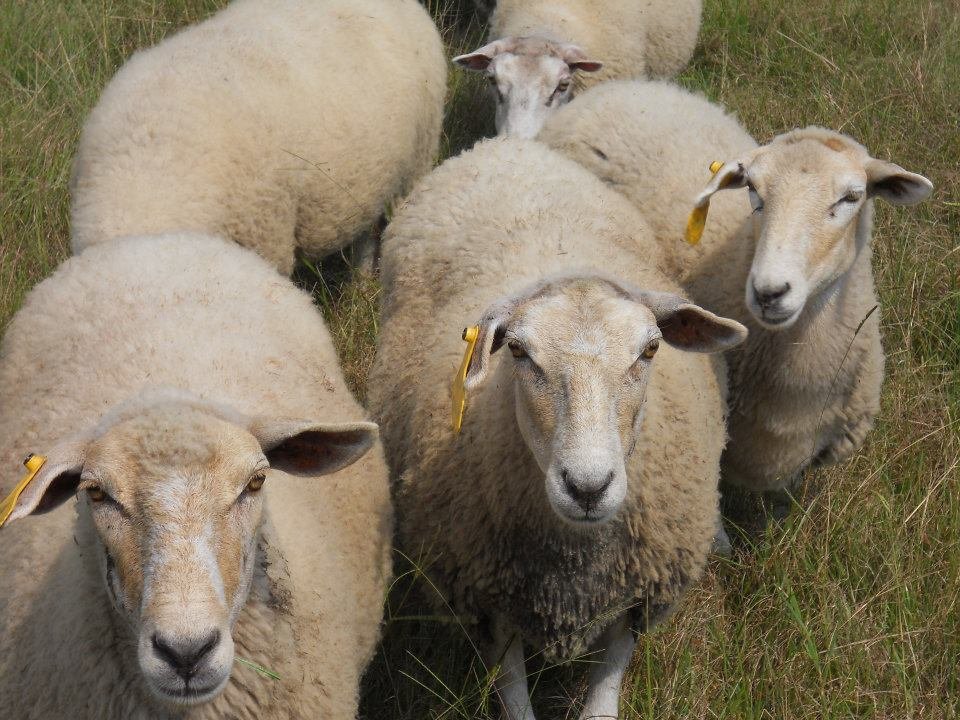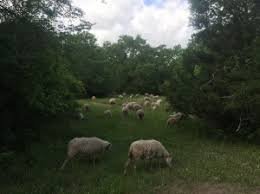June 2022: Ginger Briggs
FORGOTTEN HERITAGE AND RECONNECTING WITH AN OLD FRIEND:
My Journey of Discovery of Gulf Coast Native Sheep
Author: Ginger Briggs, GingerArt Creations
Published: June 3rd, 2022
In 2018, I curiously watched my friend, Kelli Carruth Miller, post photos on Facebook about her hobby farm in Zachery, Louisiana. Kelli and I traveled in the same circle of friends at Baton Rouge High School from 1980 to 1984. She was the sweet, quiet member of our group and, I admit, we were not very close; just good acquaintances. Facebook reconnected us, as social media tends to do, but, little did I know that this reconnection would send me on a historical and creative journey as an artist in a new medium….fiber. It all started with the breed of Gulf Coast Native Sheep, which Kelli was raising on her hobby farm in Zachery, Louisiana.
The Gulf Coast Native breed sheep holds a long history in Louisiana, one I did not even know about, until I met Kelli. Since Kelli was better at the written word than myself, I will let her tell the story:
“Gulf Coast sheep are also known as Louisiana Native sheep. They are the only sheep you could say are indigenous to our southeastern, coastal United States. They are descended from sheep Christopher Columbus and his men brought over from Spain. They used to drop off their Spanish sheep and goats on the little islands in the Caribbean so that on return trips they would have a fresh meat supply. These sheep were eventually brought to the southern US. Today’s Gulf Coast breed is descended from those that survived and adapted to the heat, parasites, and other conditions of our semi-tropical climate that are perilous to other sheep.
Raising other sheep breeds here is impractical, if not impossible if they don’t also have super-impervious immune systems. As parasites have become so resistant to commercial, chemical de-wormers, having a naturally resistant breed is that much more important. Louisiana Natives (as I prefer to call them, to let people know there really are sheep that actually belong to Louisiana) are a dual purpose breed, being useful for both wool and meat. Louisiana Native sheep are one of the Heritage breeds on the critically endangered list of the American Livestock Breeds Conservancy. The ALBC is in the business of trying to educate people about restoring Heritage breeds of American livestock that are today endangered.
These are the dual purpose breeds that for centuries before 1950, sustained not only the national American economy, but American families. Heritage breeds are those poultry and livestock that transported, worked for, fed, clothed and furnished our forefathers. A Heritage breed horse was used for battle, but was also the family car, truck, and plow. Mothers used wool from Heritage breed sheep to make blankets and clothes that kept their families warm, and products that when sold paid for shelter and education. Cows and goats gave meat, leather and milk. Pigs gave ham, bacon and leather. Leather from heritage breeds made clothing, tack for horses, furniture, book covers. Eggs and meat from Heritage breed turkeys, chickens or ducks were Sunday dinner. Feathers stuffed pillows, mattresses and other furniture. Heritage breed oxen, horses, donkey and mules provided the work that cultivated and harvested crops; cut and hauled the lumber and other goods that built the homes, barns, churches, schools, shops, banks and government buildings in the towns. Every aspect of American life was provided for either directly or indirectly by some American heritage breed poultry or livestock animal.
Today we have Wal-Mart; yesterday we had Heritage breeds. Heritage breeds were practical for the family farm as they thrive with very little input. They can survive off the land on their own, with little or no extra feed. They are hardy, naturally healthy, naturally low maintenance, thrifty animals. Without them, America would have developed into a very different nation, if it could have developed at all. These breeds are endangered today, because of the shift into industrialized farming, and away from the family farm that began around the end of World War II.
As people have abandoned the local, family farm, these amazing heritage breeds are now threatened with extinction. Some small scale hobby farmers are working to bring them back, and it is my own goal to contribute to this effort. But as far as I can tell, most participating in the organized effort seem to have very small flocks (I’ve yet to find someone who’s flock is over even 20) and I worry that it won’t be enough. After WWII, there were literally hundreds of thousands of Louisiana Native sheep grazing unimproved lands of the Southeast United States. Today, there are fewer than 2,000.”- Kelli Carruth Miller (from her website A Sheep Like Faith).
Kelli introduced me to Gulf Coast Native wool fiber (GCN) and, pretty soon, I was caught up in her passion of spinning, knitting, crocheting , weaving and felting fiber nor only from GCN sheep, but from other heritage breeds as well. GCN fiber is still my favorite though, as the yarn is the perfect weight for Southern winters and is an excellent yarn to mix with other fibers due to it’s durability. Fibers take dye easily; however, I love the natural colors of buttery whites, browns and even black.
If you have not noticed, I have been referring to Kelli in the past tense. Kelli left us in January 2020. The entire time we had reconnected, she was battling metastasized breast cancer. This did not stop her from her passion of shepherding, writing a book called “Green Grass, Still Waters, Woolford the Lamb Explains the Lord’s Prayer”, which is still in print today, educating people about the importance of sheep and our heritage breeds, and being one of my “new” old best friends. I have picked up where she left off and continue to tell the story of the Gulf Coast Native Breed and to create with the fiber the sheep produce. My current stash of GCN yarn is from Kelli’s sheep and I cannot help but smile each time I finish a piece.


